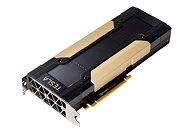Tuesday, November 26th 2019

NVIDIA Unveils Tesla V100s Compute Accelerator
NVIDIA updated its compute accelerator product stack with the new Tesla V100s. Available only in the PCIe add-in card (AIC) form-factor for now, the V100s is positioned above the V100 PCIe, and is equipped with faster memory, besides a few silicon-level changes (possibly higher clock-speeds), to facilitate significant increases in throughput. To begin with, the V100s is equipped with 32 GB of HBM2 memory across a 4096-bit memory interface, with higher 553 MHz (1106 MHz effective) memory clock, compared to the 876 MHz memory clock of the V100. This yields a memory bandwidth of roughly 1,134 GB/s compared to 900 GB/s of the V100 PCIe.
NVIDIA did not detail changes to the GPU's core clock-speed, but mentioned the performance throughput numbers on offer: 8.2 TFLOP/s double-precision floating-point performance versus 7 TFLOP/s on the original V100 PCIe; 16.4 TFLOP/s single-precision compared to 14 TFLOP/s on the V100 PCIe; and 130 TFLOP/s deep-learning ops versus 112 TFLOP/s on the V100 PCIe. Company-rated power figures remain unchanged at 250 W typical board power. The company didn't reveal pricing.
NVIDIA did not detail changes to the GPU's core clock-speed, but mentioned the performance throughput numbers on offer: 8.2 TFLOP/s double-precision floating-point performance versus 7 TFLOP/s on the original V100 PCIe; 16.4 TFLOP/s single-precision compared to 14 TFLOP/s on the V100 PCIe; and 130 TFLOP/s deep-learning ops versus 112 TFLOP/s on the V100 PCIe. Company-rated power figures remain unchanged at 250 W typical board power. The company didn't reveal pricing.

10 Comments on NVIDIA Unveils Tesla V100s Compute Accelerator
Thats what you get for paying 300k EURO on Nvidia Server.
The middle Finger.
I'm sorry but... what did you expect, an email from them warning you about an upcoming product telling you "please, don't purchase this stock from us, we are launching a newer technology, like we always do on an annual basis"
Really?
Do you remember the 90s and early zeros? CPUs got twice as fast each year and a half. You must have been constantly mad at the time. If you didn't upgrade your PC each 2-3 years it began to run at a snail's pace. Meanwhile recently you could easily get away with running your PC for up to 10 years without any issues. Sandy Bridge systems are still perfectly capable of web browsing and office work - just make sure you have more than 4 gigs of RAM. You didn't have this luxury just 20 years ago.
Did you spec your purchase appropriately for the intended workload?
Then you have nothing to complain about. The hardware you purchased is just as fast today, despite the introduction of new hardware.
When they released the new hardware, it means 2 things:
1. old hardware becomes cheaper and the improved one takes its current price
2. based on 1. he could either have gotten the same performance CHEAPER or a GREATER performance for the same cost, either way, he got screwed.
Surely we are talking about a 15-20% increase, but still.